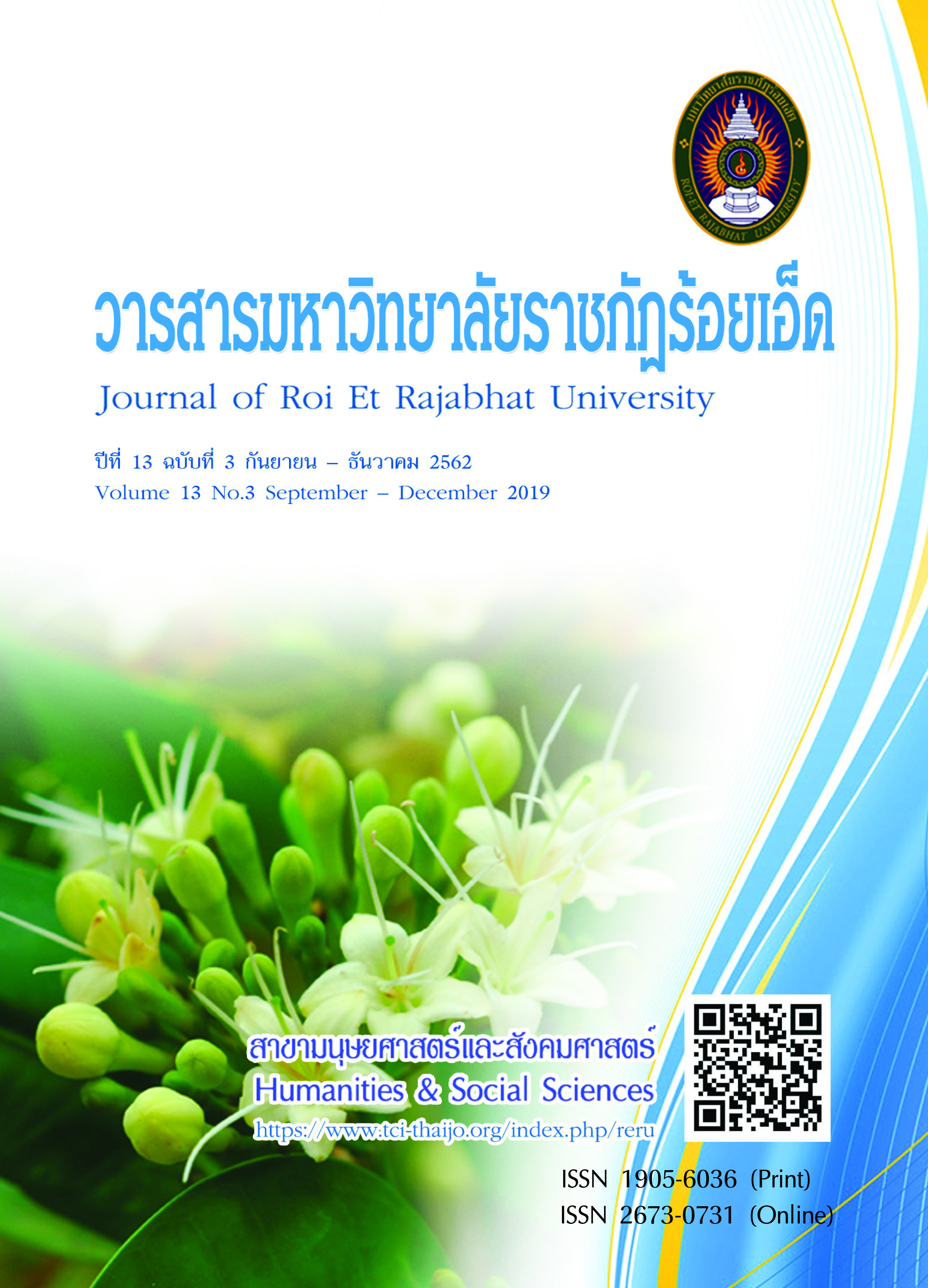การพัฒนาตัวบ่งชี้ปัจจัยดึงดูดที่กำหนดแรงจูงใจในการท่องเที่ยวของวนอุทยานแห่งชาติ ภูฝอยลม จังหวัดอุดรธานี
คำสำคัญ:
แรงจูงใจในการท่องเที่ยว, ความยากง่ายในการเข้าถึงแหล่งท่องเที่ยว, ทรัพยากรธรรมชาติบทคัดย่อ
การวิจัยในครั้งนี้มีวัตถุประสงค์เพื่อ 1) พัฒนาตัวบ่งชี้ปัจจัยดึงดูดที่กำหนดแรงจูงใจในการท่องเที่ยวของวนอุทยานแห่งชาติภูฝอยลม จังหวัดอุดรธานี 2) ตรวจสอบความตรงเชิงโครงสร้างของแบบจำลองปัจจัยดึงดูดที่กำหนดแรงจูงใจ ในการท่องเที่ยวของวนอุทยานแห่งชาติภูฝอยลม จังหวัดอุดรธานี ด้วยการวิเคราะห์องค์ประกอบเชิงยืนยันอันดับสอง กลุ่มตัวอย่างเป็นนักท่องเที่ยวที่เดินทางมายังวนอุทยานแห่งชาติภูฝอยลม จังหวัดอุดรธานี จำนวน 480 คน จากจำนวนประชากรทั้งหมด 292,211 คน โดยกลุ่ม EFA ตอบกลับมาจำนวน 240 คน และกลุ่ม CFA ตอบกลับมาจำนวน 240 คน เครื่องมือที่ใช้ในการวิจัย คือ แบบวัดปัจจัยดึงดูดที่กำหนดแรงจูงใจในการท่องเที่ยว ทำการวิเคราะห์ข้อมูลด้วยวิธีวิเคราะห์องค์ประกอบเชิงสำรวจและวิเคราะห์องค์ประกอบเชิงยืนยันอันดับสอง ผลการวิจัยพบว่า การวิเคราะห์องค์ประกอบเชิงสำรวจ (EFA) ได้องค์ประกอบจำนวน 4 องค์ประกอบ (KMO = 0.845) มีจำนวนองค์ประกอบและตัวบ่งชี้ไม่แตกต่างจากโมเดลตามทฤษฎีที่ได้จากการวิเคราะห์องค์ประกอบเชิงยืนยันอันดับสอง (CFA) ได้องค์ประกอบจำนวน 4 องค์ประกอบ ได้แก่ ความยากง่ายในการเข้าถึงแหล่งท่องเที่ยว, ทรัพยากรธรรมชาติ, สิ่งอำนวยความสะดวก และกิจกรรมและเหตุการณ์พิเศษ โดยมีดัชนีความกลมกลืนดังนี้ ค่า =93.756 ค่า /df =1.019 ค่า GFI = 0.952 ค่า AGFI = 0.928 ค่า CFI = 0.999 ค่า Standardized RMR = 0.046 และค่า RMSEA = 0.009
เอกสารอ้างอิง
สืบค้นเมื่อ 10 ตุลาคม 2561, จาก https://www.mots.go.th/more_news.php?cid=504&filename=index
กลุ่มข้อมูลสารสนเทศและการสื่อสาร. (2561). แผนพัฒนาจังหวัดอุดรธานี พ.ศ. 2561-2564. อุดรธานี: สำนักงานจังหวัดอุดรธานี.
เจนจิรา บรรจงนึก. (2555). แรงจูงใจและความพึงพอใจที่มีต่อนักท่องเที่ยวจังหวัดน่าน. วิทยานิพนธ์ ศิลปศาสตรมหาบัณฑิต สาขาวิชาการจัดการการท่องเที่ยว. กรุงเทพฯ: มหาวิทยาลัยธุรกิจบัณฑิต.
ฟูศักดิ์ กาญจนสำราญวงศ์. (2546). การวิเคราะห์แรงจูงใจของนักท่องเที่ยวในการเลือกแหล่งและฤดูกาลท่องเที่ยว
ในแหล่งนันทนาการทางธรรมชาติ: กรณีศึกษาอุทยานแห่งชาติดอยอินทนนท์และเขาใหญ่. วิทยานิพนธ์
วิทยาศาสตรมหาบัณฑิต สาขาวิชาการบริหารทรัพยากรป่าไม้. กรุงเทพฯ: มหาวิทยาลัยเกษตรศาสตร์.
วิคิเนีย มายอร์. (2555). แรงจูงใจและความพึงพอใจของนักท่องเที่ยวที่เดินทางมายังบ่อน้ำร้อนรักษะวารินและบ่อน้ำร้อนพรรั้ง จังหวัดระนอง. วิทยานิพนธ์ ศิลปศาสตรมหาบัณฑิต สาขาวิชาการจัดการการท่องเที่ยว. กรุงเทพฯ: มหาวิทยาลัยธุรกิจบัณฑิต.
ศิริเพ็ญ ดาบเพชร. (2557). การเลือกสถานที่ท่องเที่ยวของนักท่องเที่ยวครั้งแรกและนักท่องเที่ยวซ้ำ. วารสารบริหารธุรกิจ เศรษฐศาสตรและการสื่อสาร, 9(2), 39-59.
สำนักงานบริหารพื้นที่อนุรักษ์ที่ 10 อุดรธานี. (2560). ภูฝอยลม ผืนป่า ธรรมชาติ และแหล่งท่องเที่ยวใกล้เมืองอุดรธานี. อุดรธานี: สำนักงานจังหวัดอุดรธานี.
สำนักงานประชาสัมพันธ์จังหวัดอุดรธานี. (2561). สถิตินักท่องเที่ยว ณ สวยรวมพรรณไม้ป่า 60 พรรษา มหาราชินี
ภาคตะวันออกเฉียงเหนือ (ภูฝอยลม). อุดรธานี: สำนักงานจังหวัดอุดรธานี.
Baniya & Paudel. (2016). An Analysis of Push and Pull Travel Motivations of Domestic Tourists in Nepal. Journal of Management and Development Studies, 27(1), 16-30.
Bollen, K.A. (1989). Structural Equations with Latent Variables. New York: John Wiley and Sons.
Chen, Y. F., & Mo, H. E. (2014). A Survey of Push and Pull Motivations of Green Event Tourists.
International Journal of Information and Education Technology, 4(3), 260.
Getz, D. (1997). Event management and event tourism. New York: Cognizant Communications Corporation.
Getz, D. (2008). Event tourism: Definition, evolution, and research. Tourism Management, 29(3), 403–428.
Hair Jr., J.F., Black, W.C., Babin, B.J. & Anderson, R.E. (2010). Multivariate Data Analysis: A Global
Perspective (7th Edition). New Jersey: Pearson Prentice Hall.
Hu, L. & Bentler, P. (1999). Cutoff criteria for fit indices in covariance structure analysis: conventional criteria versus new alternatives. Structural Equation Modeling: A Multidisciplinary Journal, 6, 1-55.
Iso-Ahola, S. E., & Allen, J. R. (1982). The dynamics of leisure motivation: The effects of outcome on leisure needs. Re-search Quarterly for Exercise and Sport, 53(2), 141–149.
Jefrri, Y. (2001). Tourism the best solution for economic problem in Saudi Arabia. Working paper presented to the symposium of the economic effect of tourism. Jeddah: King Abdulaziz University.
Jöreskog, K.G. & Sörbom, D. (1989). LISREL-7 user's reference guide. Mooresville. Indiana: Scientific Software.
Klenosky, D. B. (2002). The pull of tourism destinations a means-end investigation. Journal of Travel Research, 40(1), 385-395.
Kozak, M. (2002). Comparative analysis of tourist motivations by nationality and destinations.
Tourism management, 23(3), 221-232.
Lee, S., Phau, I., and Quintal, V. (2012). Factors Influencing Decisions to Visit Private Parks: The Case of Araluen Botanic Park WA. In Proceedings of the Australian and New Zealand. Journal of Vacation Marketing, 19(3), 269–284.
Lohmann, M., and Kaim, E. (1999). Weather and holiday destination preferences, image attitude
and experience. The Tourist Review, 2(2), 54-64.
Mak, A. H., Lumbers, M., Eves, A., & Chang, R. C. (2012). Factors influencing tourist food consumption. International Journal of Hospitality Management, 31(3), 928-936.
Mehmetoglu, M., & Ellingsen, K. (2005). Do small-scale festivals adopt “market orientation”
as a management philosophy?. Event Management, 9(3), 119–132.
Mohammad and Som. (2010). An Analysis of Push and Pull Travel Motivations of Foreign Tourists
to Jordan. International Journal of Business and Management, 5(12), 41-50.
Nevitt, J., & Hancock, G. R. (2001). Performance of bootstrapping approaches to model test statistics
and parameter standard error estimation in structural equation modeling. Structural Equation Modeling, 8(3), 353-377.
Nunnally, J.C. (1978). Psychometric theory (2nd Edition). New York: McGraw-Hill.
Steiger JH. (2000). Point estimation, hypothesis testing, and interval estimation using the RMSEA: Some comments and a reply to Hayduk and Glaser. Structural Equation Modeling, 7(2), 149–162.
Tsaur, Sheng-Hshiung, Kanyarat Saenchan, and Wongladda Weerapaiboon. (2013). The Comparison of Travel Motivations for International Youth Independent Travelers to Taiwan and Thailand,
19th Asia Pacific Tourism Association Annual Conference 2013, Bangkok, Thailand.
Yong, A. G., & Pearce, S. (2013). A beginner’s guide to factor analysis: Focusing on exploratory factor analysis. Tutorials in Quantitative Methods for Psychology, 9(2), 79–94.
Yousefi, M., & Marzuki, A. (2015). An analysis of push and pull motivational factors of international tourists to Penang, Malaysia. International Journal of Hospitality & Tourism Administration, 16(1), 40-56.
ดาวน์โหลด
เผยแพร่แล้ว
รูปแบบการอ้างอิง
ฉบับ
ประเภทบทความ
สัญญาอนุญาต
บทความที่ได้รับการตีพิมพ์เป็นลิขสิทธิ์ของวารสารมหาวิทยาลัยราชภัฎร้อยเอ็ด
ข้อความที่ปรากฏในบทความแต่ละเรื่องในวารสารวิชาการเล่มนี้เป็นความคิดเห็นส่วนตัวของผู้เขียนแต่ละท่านไม่เกี่ยวข้องกับมหาวิทยาลัยราชภัฎร้อยเอ็ด และคณาจารย์ท่านอื่นๆในมหาวิทยาลัยฯ แต่อย่างใด ความรับผิดชอบองค์ประกอบทั้งหมดของบทความแต่ละเรื่องเป็นของผู้เขียนแต่ละท่าน หากมีความผิดพลาดใดๆ ผู้เขียนแต่ละท่านจะรับผิดชอบบทความของตนเองแต่ผู้เดียว





